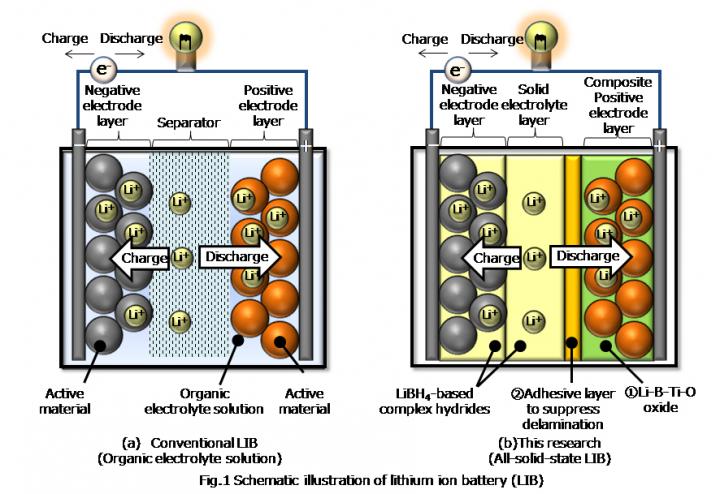Basic technology of high thermally-durable all-solid-state lithium ion battery developed

This is a schematic illustration of lithium ion battery (LIB). Credit: Hitachi, Ltd.
The high energy density Li-ion battery is already being used as power sources in applications such as portable devices (smartphones and tablets), electric vehicles and adjustor of the supply and demand of renewable energy.
The conventional Li-ion battery consists of a separator, a positive electrode layer and a negative electrode layer (Fig.1 (a)). The battery is filled with organic electrolyte solution in which lithium ion conducts between the two electrode layers during the charge and discharge process.
An issue of the conventional Li-ion battery, with the organic electrolyte solution, is thermal durability. The upper operating temperature is limited to around 60°C owing to volatility of the organic electrolyte solution. Consequently, it is difficult to use the conventional Li-ion battery in a high temperature environment without a cooling system.
Therefore, the solid electrolyte with no volatility has been developed for the utilization of Li-ion battery in a high temperature environment. The lithium ion conductivity of solid electrolyte, however, is lower than that of the organic electrolyte solution, and the internal resistance of all-solid-state Li-ion battery should be reduced for its commercialization.
Prof. Shin-ichi Orimo's lab in AIMR and the Institute for Material Research at Tohoku University have been conducting research on LiBH4-based complex hydrides as novel and solid electrolytes. They have confirmed the fast lithium ion conductivity in the wide temperature range from room temperature to 150°C.
###
Details of the technology developed are as below:
Composite positive electrode layer to suppress the decomposition of active materials at interface*1
Adhesive layer for reducing the interface resistance between solid electrolyte and composite positive electrode layer
*1 Interface: Boundary formed between different solid materials
This research was part of a collaborative project between Hitachi and AIMR called “Collaborative Research for Next Generation Innovative Battery.” The findings of this research were partially presented on November 13, 2015 at the 56th Battery Symposium, held in Aichi Prefecture.
Media Contact
All latest news from the category: Power and Electrical Engineering
This topic covers issues related to energy generation, conversion, transportation and consumption and how the industry is addressing the challenge of energy efficiency in general.
innovations-report provides in-depth and informative reports and articles on subjects ranging from wind energy, fuel cell technology, solar energy, geothermal energy, petroleum, gas, nuclear engineering, alternative energy and energy efficiency to fusion, hydrogen and superconductor technologies.
Newest articles

Silicon Carbide Innovation Alliance to drive industrial-scale semiconductor work
Known for its ability to withstand extreme environments and high voltages, silicon carbide (SiC) is a semiconducting material made up of silicon and carbon atoms arranged into crystals that is…

New SPECT/CT technique shows impressive biomarker identification
…offers increased access for prostate cancer patients. A novel SPECT/CT acquisition method can accurately detect radiopharmaceutical biodistribution in a convenient manner for prostate cancer patients, opening the door for more…

How 3D printers can give robots a soft touch
Soft skin coverings and touch sensors have emerged as a promising feature for robots that are both safer and more intuitive for human interaction, but they are expensive and difficult…





















